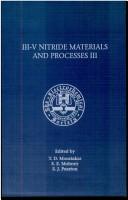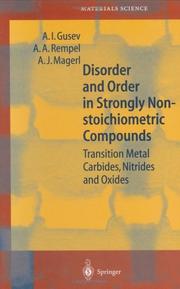| Listing 1 - 10 of 10 |
Sort by
|
Book
ISBN: 9789175198439 Year: 2012 Publisher: Linkopings Universitet
Abstract | Keywords | Export | Availability | Bookmark
 Loading...
Loading...Choose an application
- Reference Manager
- EndNote
- RefWorks (Direct export to RefWorks)
This thesis by Hanna Fager explores the growth and properties of amorphous TiAlSiN and HfAlSiN thin films for cutting tool applications. It aims to extend the understanding of amorphous nitride thin films, describe their growth processes, and explore their potential applications. The study involves the fabrication of thin films using industrial cathodic arc evaporation and reactive magnetron sputtering, with detailed analysis of their composition, nanostructure, and mechanical properties. The research highlights the thermal stability, hardness, and fracture toughness of these films, making them suitable for advanced material applications in industry.

ISBN: 1566772125 Year: 1999 Publisher: Pennington (N.J.) : Electrochemical society,
Abstract | Keywords | Export | Availability | Bookmark
 Loading...
Loading...Choose an application
- Reference Manager
- EndNote
- RefWorks (Direct export to RefWorks)
Electronics --- Semiconductors --- Transition metal nitrides --- Materials --- Materials
Book
ISBN: 9789176856840 Year: 2016 Publisher: Linkopings Universitet
Abstract | Keywords | Export | Availability | Bookmark
 Loading...
Loading...Choose an application
- Reference Manager
- EndNote
- RefWorks (Direct export to RefWorks)
This thesis by Daniel Edström explores the growth and mechanical properties of transition metal nitrides and carbides, with a focus on titanium nitride (TiN) as a model system. Utilizing computational methods like classical molecular dynamics and density functional theory, the study investigates atomic-scale processes during thin film growth and the mechanical behavior of these materials. The research aims to optimize experimental parameters to enhance film properties, particularly ductility, in transition metal nitride alloys. The findings demonstrate that optimizing valence electron concentration can improve toughness, while maintaining the inherent hardness of these ceramic materials. The work is intended for materials scientists and engineers interested in advanced functional materials and protective coatings.

ISBN: 0521418852 Year: 1994 Publisher: Cambridge Cambridge University press
Abstract | Keywords | Export | Availability | Bookmark
 Loading...
Loading...Choose an application
- Reference Manager
- EndNote
- RefWorks (Direct export to RefWorks)
Electron metallography --- Transition metal carbides --- Transition metal nitrides --- Metallography
Book
ISBN: 0511881045 0511629036 Year: 1994 Publisher: Cambridge : Cambridge University Press,
Abstract | Keywords | Export | Availability | Bookmark
 Loading...
Loading...Choose an application
- Reference Manager
- EndNote
- RefWorks (Direct export to RefWorks)
This book presents a systematic description of the electronic and physico-chemical properties of transition-metal carbides and nitrides. This is the first book devoted to the theoretical modelling of refractory carbides and nitrides and alloys based on them. It makes use of computational methods to calculate their spectroscopic, electric, magnetic, superconducting, thermodynamical and mechanical properties. Calculated results on the electronic band structure of ideal binary transition metal carbides and nitrides are presented, and the influence of crystal lattice defects, vacancies and impurities are studied in detail. Data available on chemical bonding and the properties of multi-component carbide- and nitride-based alloys, as well as their surface electronic structure, are described and compared with those of bulk crystals.
Transition metal carbides --- Transition metal nitrides --- Electron metallography. --- Metallography.

ISBN: 3540418172 Year: 2001 Publisher: Berlin : Springer,
Abstract | Keywords | Export | Availability | Bookmark
 Loading...
Loading...Choose an application
- Reference Manager
- EndNote
- RefWorks (Direct export to RefWorks)
Book
ISBN: 9781624173622 1624173624 9781613241820 1613241828 Year: 2012 Publisher: New York
Abstract | Keywords | Export | Availability | Bookmark
 Loading...
Loading...Choose an application
- Reference Manager
- EndNote
- RefWorks (Direct export to RefWorks)
Ceramic metals. --- Transition metal carbides. --- Transition metal nitrides. --- Phase rule and equilibrium. --- Nitrides --- Transition metal compounds --- Carbides --- Cermets --- Metal ceramics --- Metallic ceramics --- Ceramic materials --- Heat resistant materials --- Powder metallurgy --- Chemistry, Physical and theoretical --- Critical phenomena (Physics) --- Equilibrium --- Chemical equilibrium --- Chemical systems --- Critical point
Book
Year: 2020 Publisher: Basel, Switzerland MDPI - Multidisciplinary Digital Publishing Institute
Abstract | Keywords | Export | Availability | Bookmark
 Loading...
Loading...Choose an application
- Reference Manager
- EndNote
- RefWorks (Direct export to RefWorks)
Catalysts are made of nanoparticles of metals, metal oxides, and other compounds that may act as active phases, support the latter, or a combination of both. The initial incentive to reduce as much as possible, up to the nano-scale, the size of the particles of active catalyst components is to maximize the surface area exposed to reactants, thus minimizing the specific cost per function and increasing the rate of conversion of feedstocks to products in relatively simple reactions. Nowadays, the interest in nanocatalyst developments has shifted to an emphasis on improving the selectivity of catalysts, allowing one to obtain desirable reactions in more complex synthetic processes. Thus, new generations of nanocatalysts should be designed at the molecular level to display well-defined structural characteristics, in terms of size, shapes, hierarchical porosity, and morphologies, as well as with controlled chemical composition. The development of efficient nanocatalysts supposes the characterization of their various surface active sites at the nanometer scale, which is focused on establishing synthesis–structure–performance relationships.
Research & information: general --- plasmonic photocatalyst --- metal nanoparticle --- N–TiO2 --- nanocomposites --- photocatalytic selective oxidation --- heterogeneous catalysis --- transition metal nitrides --- hydrogen production --- formic acid decomposition --- nickel catalyst --- calcium oxide promoter --- silica support --- Iron-based perovskites --- copper --- NO oxidation to NO2 --- NO2-assisted diesel soot oxidation --- soot oxidation under GDI exhaust conditions --- aqueous-phase reforming --- nickel --- ceria --- zirconia --- calcium --- yttrium --- methanol --- graphite --- reduced graphene oxide --- nitrogen-doped reduced graphene oxide --- exfoliation --- oxygen reduction reaction --- electrocatalysis --- UiO-66 --- iron --- cobalt --- nanocatalyst --- CO oxidation --- COProx --- methane --- oxidation catalysis --- formaldehyde --- magnetite iron oxide --- Fe3O4 --- palladium --- Pd --- silver --- Ag --- low-temperature activity --- nanocomposite --- Raman --- TG in air --- TG in hydrogen --- XRD --- electron microscopy --- EDS --- coordination polymers --- methane storage --- XRD crystallinity measurements --- mechanical shaping --- compaction --- VAM --- gas separation --- MOF pelletization --- catalysts --- dimerization --- isobutene --- olefins --- plasmonic photocatalyst --- metal nanoparticle --- N–TiO2 --- nanocomposites --- photocatalytic selective oxidation --- heterogeneous catalysis --- transition metal nitrides --- hydrogen production --- formic acid decomposition --- nickel catalyst --- calcium oxide promoter --- silica support --- Iron-based perovskites --- copper --- NO oxidation to NO2 --- NO2-assisted diesel soot oxidation --- soot oxidation under GDI exhaust conditions --- aqueous-phase reforming --- nickel --- ceria --- zirconia --- calcium --- yttrium --- methanol --- graphite --- reduced graphene oxide --- nitrogen-doped reduced graphene oxide --- exfoliation --- oxygen reduction reaction --- electrocatalysis --- UiO-66 --- iron --- cobalt --- nanocatalyst --- CO oxidation --- COProx --- methane --- oxidation catalysis --- formaldehyde --- magnetite iron oxide --- Fe3O4 --- palladium --- Pd --- silver --- Ag --- low-temperature activity --- nanocomposite --- Raman --- TG in air --- TG in hydrogen --- XRD --- electron microscopy --- EDS --- coordination polymers --- methane storage --- XRD crystallinity measurements --- mechanical shaping --- compaction --- VAM --- gas separation --- MOF pelletization --- catalysts --- dimerization --- isobutene --- olefins
Book
ISBN: 3039219030 3039219022 Year: 2019 Publisher: MDPI - Multidisciplinary Digital Publishing Institute
Abstract | Keywords | Export | Availability | Bookmark
 Loading...
Loading...Choose an application
- Reference Manager
- EndNote
- RefWorks (Direct export to RefWorks)
This book is dedicated to highlighting some relevant advances in the field of thin films and coatings based on two-dimensional crystals and layered nanomaterials. Due to their layered structure, graphene and a variety of new 2D inorganic nanosystems, called “graphene analogues”, have all attracted tremendous interest due to their unprecedented properties/superior performance, and may find applications in many fields from electronics to biotechnology. These two-dimensional systems are ultrathin and, hence, tend to be flexible, also presenting distinctive and nearly intrinsic characteristics, including electronic, magnetic, optical, thermal conductivity, and superconducting properties. Furthermore, the combination of different structures and synergetic effects may open new and unprecedented perspectives, making these ideal advanced materials for multifunctional assembled systems. As far as the field of coatings is concerned, new layered nanostructures may offer unique and multifunctional properties, including gas barrier, lubricant, conductive, magnetic, photoactive, self-cleaning, and/or antimicrobial surfaces. This book contains new findings on the synthesis and perspectives of multifunctional films that are at the forefront of the science and coating technologies.
MoS2 nanosheets --- composites coating --- corrosion --- transition metal nitrides --- electrochemical delamination --- Cu film --- dye-sensitized solar cells --- layered materials --- electroless NiP alloy --- bubble transfer --- PtPd --- photoresponse --- van der Waals heterostructures --- MoS2 --- stanene --- water --- microbial fuel cells --- counter electrode --- PEMFC --- combustion --- molybdenum disulfide --- silicene --- free-standing films --- energy conversion efficiency --- nanowire --- chemical vapor transport deposition --- transition metal carbides --- nondestructive --- reusability --- tungsten disulfide --- graphene --- surface enhanced Raman spectroscopy --- 2D --- reduced graphene oxide --- transition metal dichalcogenides --- epitaxial growth --- WS2 --- Pt nanoparticles --- graphene/MoS2/Si heterostructure --- mechanism --- thermal management --- transition metal carbonitrides --- interfaces --- photoluminescence --- air-cathode --- germanene --- 2D materials --- microhardness --- monolayer --- coatings --- stainless steel mesh electrode --- carbon nitride --- chemical vapor deposition --- two-dimensional materials --- plasma --- thermal conductivity --- plasmonic structure --- graphene suspension
Book
Year: 2020 Publisher: Basel, Switzerland MDPI - Multidisciplinary Digital Publishing Institute
Abstract | Keywords | Export | Availability | Bookmark
 Loading...
Loading...Choose an application
- Reference Manager
- EndNote
- RefWorks (Direct export to RefWorks)
Catalysts are made of nanoparticles of metals, metal oxides, and other compounds that may act as active phases, support the latter, or a combination of both. The initial incentive to reduce as much as possible, up to the nano-scale, the size of the particles of active catalyst components is to maximize the surface area exposed to reactants, thus minimizing the specific cost per function and increasing the rate of conversion of feedstocks to products in relatively simple reactions. Nowadays, the interest in nanocatalyst developments has shifted to an emphasis on improving the selectivity of catalysts, allowing one to obtain desirable reactions in more complex synthetic processes. Thus, new generations of nanocatalysts should be designed at the molecular level to display well-defined structural characteristics, in terms of size, shapes, hierarchical porosity, and morphologies, as well as with controlled chemical composition. The development of efficient nanocatalysts supposes the characterization of their various surface active sites at the nanometer scale, which is focused on establishing synthesis–structure–performance relationships.
plasmonic photocatalyst --- metal nanoparticle --- N–TiO2 --- nanocomposites --- photocatalytic selective oxidation --- heterogeneous catalysis --- transition metal nitrides --- hydrogen production --- formic acid decomposition --- nickel catalyst --- calcium oxide promoter --- silica support --- Iron-based perovskites --- copper --- NO oxidation to NO2 --- NO2-assisted diesel soot oxidation --- soot oxidation under GDI exhaust conditions --- aqueous-phase reforming --- nickel --- ceria --- zirconia --- calcium --- yttrium --- methanol --- graphite --- reduced graphene oxide --- nitrogen-doped reduced graphene oxide --- exfoliation --- oxygen reduction reaction --- electrocatalysis --- UiO-66 --- iron --- cobalt --- nanocatalyst --- CO oxidation --- COProx --- methane --- oxidation catalysis --- formaldehyde --- magnetite iron oxide --- Fe3O4 --- palladium --- Pd --- silver --- Ag --- low-temperature activity --- nanocomposite --- Raman --- TG in air --- TG in hydrogen --- XRD --- electron microscopy --- EDS --- coordination polymers --- methane storage --- XRD crystallinity measurements --- mechanical shaping --- compaction --- VAM --- gas separation --- MOF pelletization --- catalysts --- dimerization --- isobutene --- olefins --- n/a
| Listing 1 - 10 of 10 |
Sort by
|

 Search
Search Feedback
Feedback About UniCat
About UniCat  Help
Help News
News